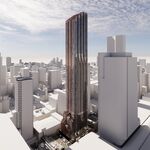And from the City of Toronto:
July 6, 2006       
OMB approval of City’s Official Plan is ‘win’ for city at large
               
The Ontario Municipal Board’s (OMB) approval today of the City of Toronto’s Official Plan is being hailed as a ‘win’ for the City, residents, communities, businesses, environmentalists, and the city at large. The document, a product of an extensive consultation process, outlines how Toronto will evolve, improve and realize its full potential in areas such as transit, land use development, and the environment over the next 25 years.
“The Official Plan is Council’s vision and the public’s voice on how to create the best quality of life for people who live, work, and invest in Toronto,†said Mayor David Miller. “The OMB’s approval is a testament to the strength of that vision and direction.â€
The Official Plan - the first since amalgamation - is City Council’s policy direction on delivering quality city living by strengthening what is referred to in the plan as the three pillars: community infrastructure, environmental health, and economic foundation.
“If you think of the Official Plan as a road map, then the three pillars are the major avenues this city must travel to deliver on Council priorities such as sustainable city building, neighbourhood protection, reducing dependency on automobiles, revitalization and a strong quality of city life,†added Ted Tyndorf, the City’s Chief Planner and Executive Director of City Planning. “All City strategies will be supporting these principles for success.â€
Public consultation has been an integral part of the planning process as residents, urban experts, industry and other interested parties helped shape the plan later approved by City Council. City staff continued to work and meet with various groups to settle concerns and answer questions about the plan before the OMB’s approval of it.
The Official Plan is the City’s only statutory document outside of the City of Toronto Act.
See the Backgrounder below for more details.
Media contacts:
Stuart Green
Deputy Communications Director
Office of Mayor David Miller
416-338-7119
Rod McPhail
Director
Transportation Planning
City Planning Division
416-392-8100
Backgrounder
OMB approves City of Toronto’s Official Plan
On July 6, 2006, the Ontario Municipal Board (OMB) issued an Order, bringing the majority of the City of Toronto’s new Official Plan into effect and repealing most of the seven municipal Official Plans that the new City of Toronto inherited. The new Official Plan is the City’s road map for successful city-building over the next 25 years. It sets out where and how growth will occur, and all of the necessary services and infrastructure that will accompany new development.
The Official Plan is the City’s only statutory document outside of the City of Toronto Act. All City activities and work must conform to the Plan’s policies and support its vision of providing a desirable quality of life, improved community infrastructure, a healthy environment and a strong economic foundation.
City Council approved the new Official Plan in 2002 after two years of extensive public consultations with Torontonians, who helped shaped the Plan. The Minister of Municipal Affairs and Housing subsequently approved it in 2003.
There were approximately 180 appeals of the Plan to the OMB. For the past three years, City staff met, listened and worked with appellants to resolve most of the appeals. This work resulted in agreed-upon modifications that maintain the Plan’s integrity and, in particular, strengthened its already robust neighbourhood protection policies.
There are a couple of key policy areas, such as rental housing protection and Section 37 (height and density incentives), that are still under appeal and will be heard at the OMB later this fall.
Official Plan Highlights
To ensure that the City of Toronto evolves, improves and realizes its full potential in areas such as transit, land use development, and the environment, the Official Plan:
* identifies where significant new jobs and housing will be encouraged
* promotes growth that is less reliant on the private automobile
* calls for a transit-based growth strategy by directing development to areas with good transit while improving transit in major growth areas
* protects the physical character of Toronto’s low-rise neighbourhoods
* emphasizes environmentally sustainable development
* contains design policies to guide the physical form of development and public realm improvements
* seeks to ensure the social and environmental infrastructure is in place to serve Toronto’s present and future residents
* protects the city’s important employment districts, and
* protects heritage buildings and resources and preserves our natural areas and ravines.
AoD




